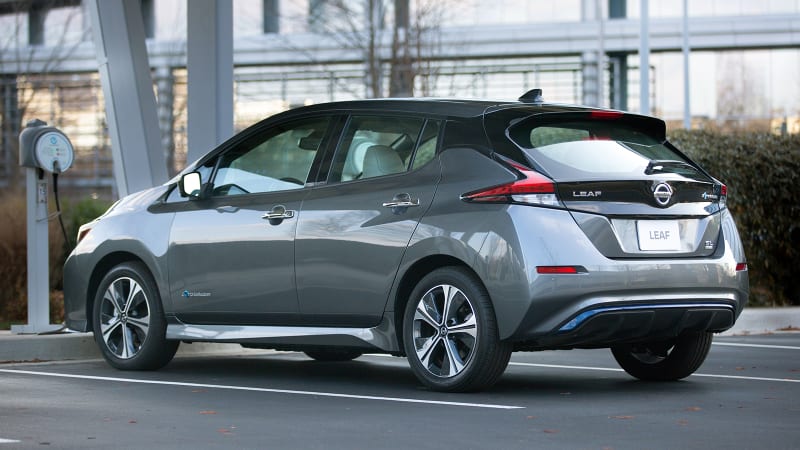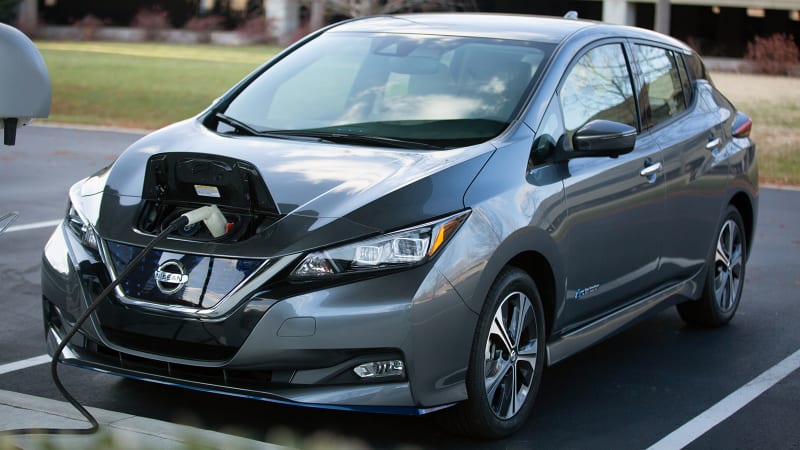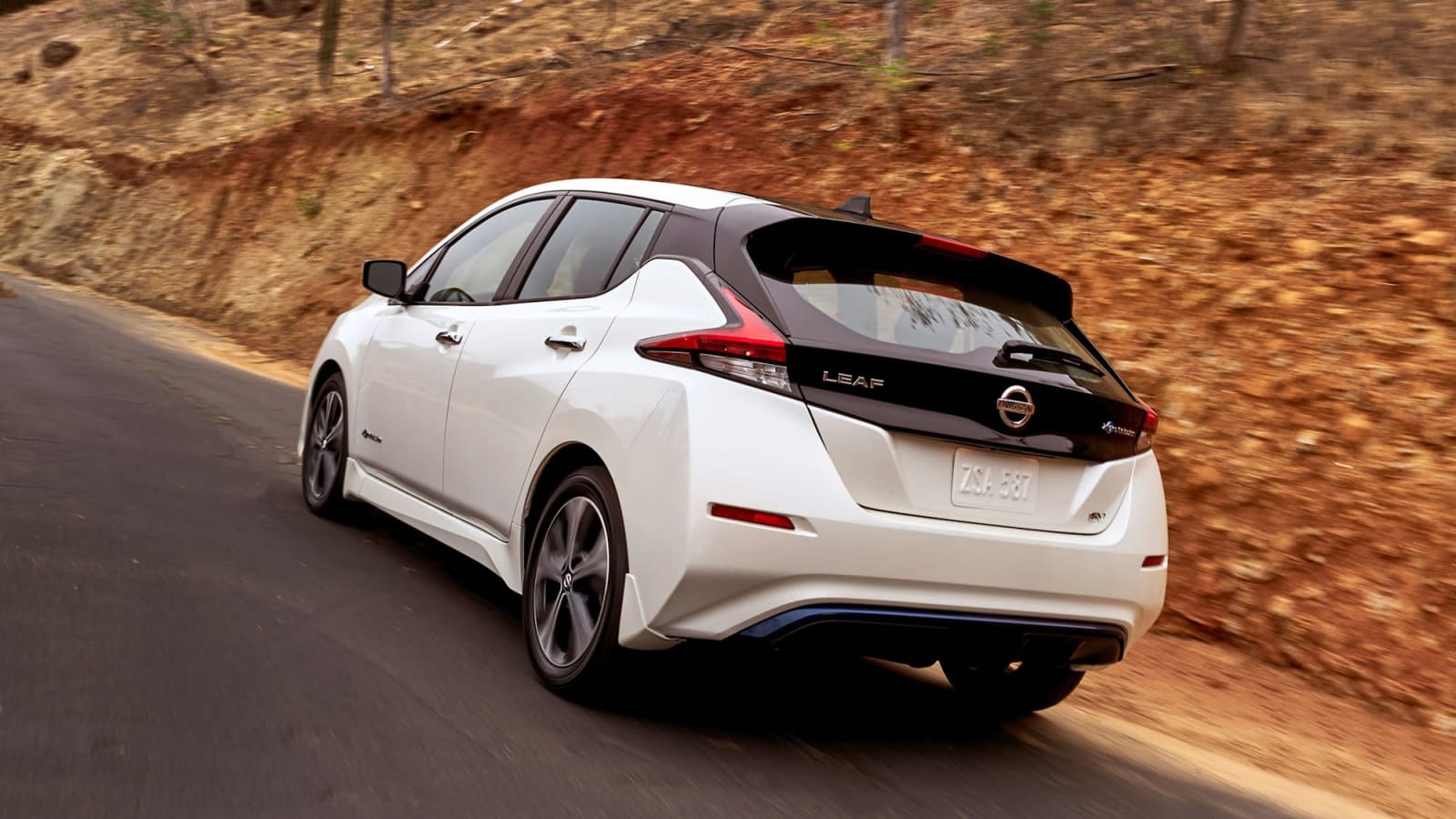Perhaps it shouldn’t be surprising, but a lower price can make a huge difference. The Nissan Leaf had started to wither on its branch as a variety of newer electric cars were introduced with longer ranges, sharper driving dynamics and more compelling designs for roughly the same price. It had become a bit hard to recommend. The 2022 Nissan Leaf is a different story, as prices have been slashed throughout the lineup resulting in better value and therefore a more competitive EV. While its rivals still enjoy the aforementioned advantages, you now have to pay more to get them.
As it is, then, the Leaf becomes the best entry-level EV choice for the money – we named it the best one for under $30,000. That goes for the longer range Leaf Plus, too, which also sees a notable price cut down to $33,375. Both versions offer sufficient range for the money (149 miles base, 215-226 for the Plus), lots of usable interior space, well-executed infotainment and safety tech, and a generally quiet and comfy ride. If you’re looking for a sensible EV that isn’t trying to make a futuristic fashion statement, it remains a smart choice. It’s just now at a smarter price.
Interior & Technology | Passenger & Cargo Space | Performance & Fuel Economy
What it’s like to drive | Pricing & Features | Crash Ratings & Safety Features
What’s new for 2022?
The Leaf is a lot cheaper this year, slashing about $5,000 off its starting price to drop well below $30,000. And that’s before the $7,500 federal tax credit. The longer-range SV Plus basically starts where the smaller battery model did at just over $33,000. You’re also getting more equipment despite the lower price as quick charge port and portable charge cable are now standard on every Leaf. There’s also the new SV Plus Technology package that adds ProPilot assist, power driver seat, LED headlights, a 360-degree parking camera and a driver inattention warning system.
What are the Leaf interior and in-car technology like?
The Leaf’s interior has a straightforward, easy-to-use interior rather than a futuristic one filled with convoluted, new-fangled controls. So, it’s less interesting, but it’s also less irritating. Materials quality is a bit better than a Hyundai Kona Electric or Chevy Bolt, but this is still a budget EV, and hard black plastics dominate most surfaces.
All Leaf models have a digital instrument panel display paired with an analog speedometer, plus an 8-inch touchscreen. The latter features customizable icon layouts, multi-touch gestures like pinch-to-zoom and the capability of software updates over Wi-Fi. Every Leaf includes wired Apple CarPlay and Android Auto, and the touchscreen itself is easy to use.
Nissan doesn’t go above and beyond with other interior features, but there are some niceties worth mentioning. Automatic climate control and an eight-way power driver’s seat are standard, while heated seats are optional. A Bose seven-speaker stereo comes standard with the SL trim. SV models and up get a heat-pump heater, which is a perk for an electric car, as it’s much more efficient and will likely help preserve some of your range when running it.
How big is the Leaf?
The Nissan Leaf is a hatchback, predictably making it practical for its size. Compared to its closest competition, the Chevrolet Bolt EV and Hyundai Kona Electric, it’s just about average for passenger interior space. Nissan wins by a couple inches when it comes to front headroom and legroom, but gives those inches back when it comes to the snug rear seat. There’s plenty of headroom in every seat for passengers over 6 feet tall, though.
It’s considerably longer than its competitors, both overall and in wheelbase, which could contribute to the Leaf’s supple ride. With all the seats in their upright position, this extra length contributes to more cargo space in the hatch than others, at 23.6 cu-ft. The seats do fold down, but the Bolt’s cargo area ends up becoming far more expansive in full luggage capacity position (the new Bolt EUV is even bigger when you lower the seats).
What are the Leaf electric range and performance specs?
The Leaf has a single permanent magnet electric motor powering the front wheels, making 147 horsepower and 236 pound-feet of torque. Nissan says that’s good for 0-60 mph in about 8 seconds, which is perfectly acceptable for a compact hatchback. Base range for this 40-kilowatt-hour version is 149 miles, and its efficiency is rated at 111 mpg-e.
Nissan made a few tweaks to the electric motor for the big-battery Leaf Plus, which pumps its output up to 214 horsepower and 250 pound-feet of torque. All that extra power brings the 0-60 mph time down to about 7 seconds. Top speed is limited to 98 mph. Range for its 62-kWh battery pack is 226 miles for the S Plus and 215 miles for the SV Plus and SL Plus, which isn’t that far off top competitors, which are around 250.
Now that both Leaf batteries are paired with a quick-charging port, Nissan says they can be charged up to 80% in 40-45 minutes using the right type of charger. The portable charge cable also lets you plug into a 240-volt home outlet (like the one your clothes dryer uses), eliminating the need for a separate home charger. Of course, you’ll still need to install a 240-volt home outlet. Keep in mind that unlike most other electric cars on the market, the Leaf’s DC fast-charging port is a CHAdeMO design. So when you’re planning a trip and planning on using fast charging, make sure stations along the route have a CHAdeMO charger, and not just the more common CCS charger.
What’s the Leaf like to drive?
We’ve driven both the normal Leaf and Leaf Plus, and both are super-comfortable commuter cars. Neither is particularly quick, but the Plus steps it up a level beyond the regular Leaf. There’s a much stronger shove into the seat from the more powerful electric motor, which explains the 1-second reduction in acceleration times. The Leaf’s throttle tuning is also very smooth compared to other EVs, though it sacrifices a bit of the competition’s more instant response.
While many EVs can be shockingly fun to drive, the Leaf merely handles at an acceptable level. A lack of steering feel is the car’s Achilles heel, and it’s less agile than its competition. It’s clear Nissan hasn’t aimed the driving feel at enthusiasts, but rather those who prioritize a smooth, comfortable ride. It succeeds in spades around town, soaking up potholes and road imperfections with ease, never jarring the passengers inside. Electric versions of the Kona and Niro aren’t exactly loud and uncomfortable, but the Leaf offers more refinement in daily driving. Less road noise seeps into the Leaf’s cabin, and the Kona/Niro cousins feel a bit stiffer over rough roads.
What other Nissan Leaf reviews can I read?
2019 Nissan Leaf Plus First Drive Review
Our review of the long-range Leaf Plus model, including what you can expect from its range and better performance.
2018 Nissan Leaf First Drive
Our initial review of the Leaf when the current generation was introduced for 2018. Included are information about it design and engineering, and driving impressions with the base battery.
How much is the 2022 Leaf price and what features are available?
Prices were slashed for 2022, making the Leaf far more competitive. The base Leaf now starts at $28,375, including the $975 destination charge, while the 60-kWh trim levels start at $33,375. Also keep in mind the $7,500 federal tax credit available plus any state-level incentives.
Standard equipment was also increased this year. The base S now includes 16-inch steel wheels, a portable charge cable, a quick charge port, cloth upholstery, automatic climate control, an 8-inch touchscreen screen, a 7-inch instrument cluster display, Apple CarPlay and Android auto, a four-speaker stereo and satellite radio. The S Plus swaps the steel wheels for 16-inch aluminum alloys.
Key upgrades for the SV include 17-inch alloy wheels, NissanConnect EV remote services, adaptive cruise control, an upgraded heater, a leather-wrapped steering wheel, heated front seats, and a six-speaker stereo. It also opens the door to a wealth of appealing upgrades in the new SV Technology package. Considering the SV’s modest price premium of $1,400, we’d start our Leaf shopping there.
The top SL trim is only available with the long-range battery. It adds LED lighting, a Bose sound system, standard ProPilot Assist (which you can read more about below), a surround-view camera system, leather seats and an auto-dimming rear-view mirror.
S: $28,375
SV: $29,775
S Plus: $33,375
SV Plus: $36,375
SL Plus: $38,375
What are the Leaf safety ratings and driver assistance features?
Every 2022 Nissan Leaf comes standard with forward collision warning with automatic emergency braking and pedestrian detection, rear automatic braking (a rare feature), blind-spot and rear cross-traffic warning systems and lane-keeping assist. The ProPilot assist system, which is standard on the SL Plus and optional through the SV Technology package, includes an advanced adaptive cruise control system with automated steering control for the highway. That package also include a driver inattention warning system. A simpler adaptive cruise control comes standard on the SV.
The federal government gives the Nissan Leaf an overall score of five stars out of five. In individual tests, it received four-star ratings for frontal and rollover crashes, and a five-star rating for side crashes. The Leaf hasn’t been subjected to the Insurance Institute for Highway Safety’s full array of safety tests, but it did receive the best-possible rating of “Good” in the moderate overlap front and side crash tests.
Source: www.autoblog.com











